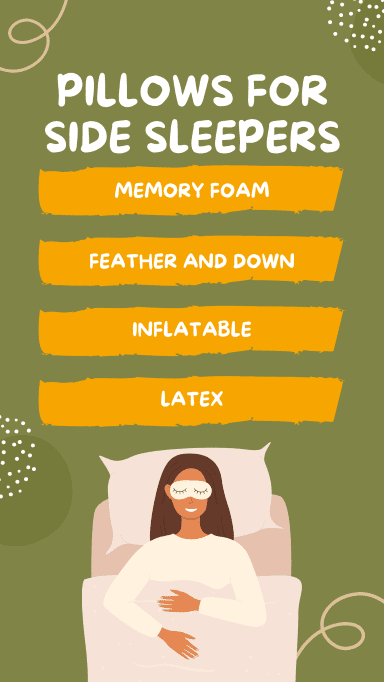What types of pillows are best for side sleepers?
If you’re a side sleeper, you know how important having a comfortable and supportive pillow is. Various pillows on the market claim to be the best for side sleepers, but knowing which is right for you can be challenging. Here is a look at some of the different types of pillows available and what they have to offer side sleepers.
What does side sleeping mean?
A side sleeper sleeps on either the left or right side of their body. This is the most common sleeping position, and it’s also the position that most health experts recommend.
Why is side sleeping the best position?
There are a few reasons why side sleeping is considered the best position. First, it helps to reduce snoring and sleep apnea. Second, it prevents you from tossing and turning throughout the night. Third, it helps to keep your spine in alignment and reduces the risk of back pain. Side sleeping allows your muscles and joints to relax, leading to better sleep.
What are the different types of pillows for side sleepers?
- Memory foam pillows are a popular option for side sleepers – Memory foam is the new kid on the pillow block but has quickly become a favourite for side sleepers. Memory foam pillows are made from a viscoelastic material that conforms to your head and neck, providing support and comfort. The foam also helps align your head and spine, which is essential for side sleepers. If you’re looking for a soft and supportive pillow, memory foam is a good option. However, it is necessary to note that memory foam can retain heat, so it may not be the best choice for hot sleepers.
- Down and feather pillows are soft and luxurious – Down and feather pillows are a classic choice for side sleepers. Down is the soft, fluffy layer beneath the feathers, providing a soft, luxurious feel. Feathers are the pillow’s outer layer, giving support and structure. Feather pillows have been used for centuries, and they are still a popular choice for side sleepers. Down and feather pillows are usually softer than other types, so they are a good choice for people who like to sleep on their side. However, they can be more expensive than different pillows and may be less supportive.
- Inflatable pillows are a good choice for travellers – An inflatable pillow is a good option if you’re looking for a compact and easy to travel with. Inflatable pillows are made from a soft, flexible material that can be inflated to the desired level of support. Many inflatable pillows come with a built-in pump, so you can easily adjust the level of firmness. Inflatable pillows aren’t only for campers and travellers, though. They can also be a good choice for side sleepers who want a pillow that is easy to adjust. You’ll find that inflatable pillows come in various shapes and sizes, so you can find one that is comfortable for you. However, they may not provide the same level of support as other types of pillows.
- Polyester fibre pillows are a good choice for people who want a firm pillow – Polyester fibre pillows are made from a synthetic material similar to down. Polyester fibre is a good choice for people who want a firm pillow because it doesn’t collapse. Polyester fibre pillows are also hypoallergenic, so they are a good choice for people with allergies. Another advantage of polyester fibre pillows is that they are usually cheaper than down pillows. That’s good news if you’re a side sleeper allergic to down.
- Latex pillows are a favourite among some side sleepers – Surprisingly, latex pillows aren’t more popular because they offer several advantages for side sleepers. Latex is a natural material that is derived from rubber trees. It is bouncy and resilient, so it springs back into shape after you’ve been lying on it. Latex pillows are hypoallergenic and suitable for people with dust allergies. They are also resistant to mould, mildew, and bacteria. That’s good news for side sleepers who want a pillow that is easy to keep clean. The feeling of latex can be a bit strange initially, but many people find it very comfortable. You’ll also find that latex pillows come in various firmness levels, so you can find one that is just right for you.

How often should you replace your pillows?
Pillows should be replaced every 1-2 years to remain supportive and comfortable. Side sleepers may need to replace their pillows more often because they put more wear and tear on them.
If you’re unsure if it’s time to replace your pillow, look at it and see if it’s starting to show signs of wear and tear. If the pillow is lumpy or misshapen, it’s time to replace it. Another thing to consider is how long you’ve had your pillow. Even if it doesn’t look like it needs to be replaced, it’s probably time for a new one if you’ve had it for over 2 years. If you’re worried about tossing it out, you can keep the pillow and put it between your legs while you sleep.
The quality of your pillow directly impacts the quality of your sleep
The average person spends about 26 years of their life asleep, which means that the quality of your pillow is directly impactful on a considerable portion of your life! If you’re a side sleeper, you know that a good pillow is essential in keeping your spine aligned and preventing neck, shoulder, and back pain. In addition to preventing pain, a good pillow can help reduce wrinkles and prevent premature ageing. A supportive pillow will keep your head level with your shoulders, taking the pressure off your muscles and allowing you to relax into a deep sleep.
Side sleepers are prone to neck pain
Side sleepers are more likely to experience neck pain than people who sleep on their backs or stomachs. That’s because when you sleep on your side, your head is bent to the side at an awkward angle. This can pressure your neck and shoulders, leading to pain over time. Side sleepers are also more likely to develop wrinkles on their faces since the side of their face is pressed into the pillow for long periods. To avoid these problems, side sleepers should use a pillow that supports their head and neck and try to change positions frequently throughout the night.
Take choosing the right pillow seriously
One of the most important things to consider when choosing a pillow is your sleeping position. If you frequently switch between positions, you may want to consider two different pillows. Side sleepers need a softer, flatter pillow, while back sleepers often prefer a firmer pillow. Stomach sleepers usually need something in between. Another critical factor is the filling. Some prefer down or feathers, while others find them too warm or uncomfortable. Synthetic fillers are usually less expensive, but some people find them less comfortable. Ultimately, choosing a comfortable pillow that supports you is essential.
Final Thoughts
Side sleepers need a soft, supportive pillow to avoid neck pain and wrinkles. They should also replace their pillows every 1-2 years to ensure they remain supportive and comfortable. Pillow quality directly impacts the quality of your sleep, so it’s essential to choose carefully. Consider your sleeping position, the filling, and personal preferences when selecting a pillow. With a little trial and error, you will find the perfect pillow for a great night’s sleep.



